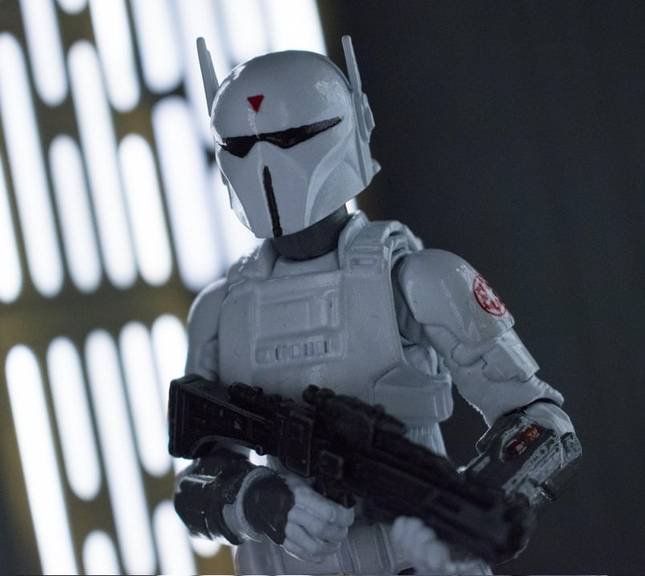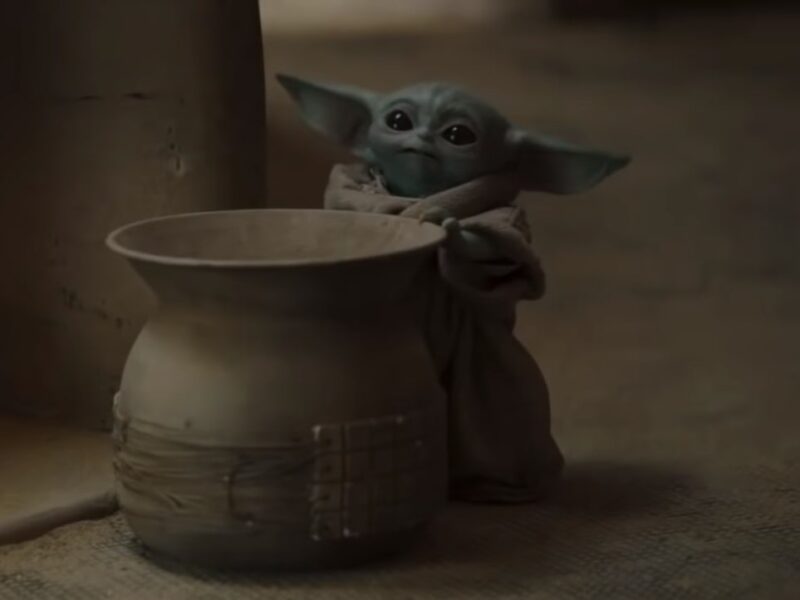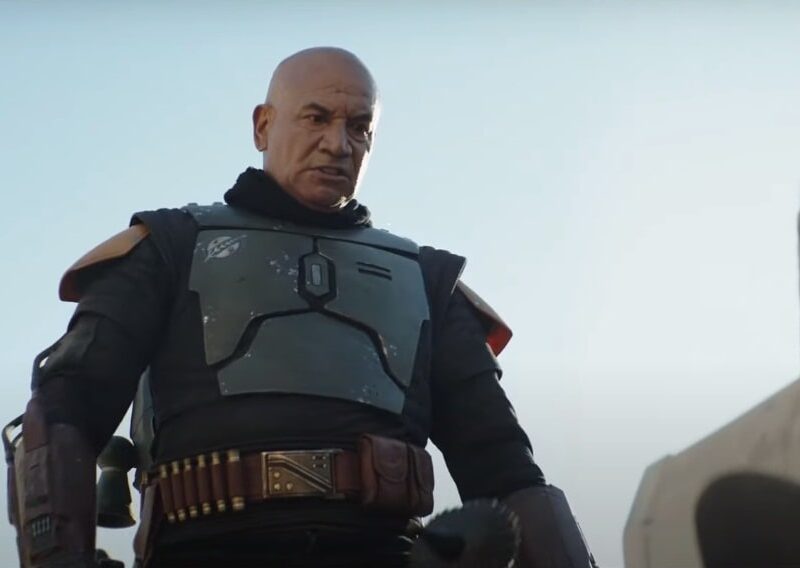1. What is Mandalorian Armor?
Mandalorian armor, called beskar’gam in the Mandalorian language, was the special armor worn by warrior groups from the planet Mandalore. This armor was known for its helmet with a T-shaped visor, which hid the wearer’s face. It also had arm guards and jetpacks.
Because of the Mandalorians’ history of fighting, their armor became a symbol that made people afraid. Most Mandalorian armor was made from beskar, one of the strongest metals in the galaxy. Sometimes it was made from other metals like durasteel.
Beskar could protect the person wearing it from blaster shots and even lightsabers. The famous bounty hunter Jango Fett, who was adopted by Mandalorians, wore custom armor made of beskar mix. His cloned son Boba later got this armor.
The Empire made a weapon called the Arc Pulse Generator that could heat up the beskar in Mandalorian armor so much that it would kill the person wearing it.
2. What Are the Components and Features of Mandalorian Armor?

A full set of Mandalorian armor had these parts:
- Helmet
- Shoulder guards
- Arm guards
- Chest plate
- Piece to protect the groin
- Knee pads
- Leg guards
All of this was worn over a full-body suit. Most Mandalorians painted their armor, but some, like Din Djarin, left their pure beskar pieces unpainted.
The helmets were very high-tech. They had:
- A special visor to see far away
- Displays inside to show important information
- A way to talk to others
- An antenna with a rangefinder that could be pulled down to make the view even better
Mandalorians also wore boots that could stick to metal surfaces.
The chest plate of the armor often had the Ka’rta symbol on it. The arm guards were full of weapons to help fight Jedi. They could have:
- Blasters
- Different kinds of darts (some that shock, paralyze, or poison)
- Flame throwers
- Grappling lines
- Lasers
- Missiles
- Spinning saw blades
- Devices to push things away
- Shield makers
- Vibrating blades
- Whip cords
- Whistling birds
Mandalorians used many types of jetpacks to fly and move better in fights. These often had launchers for missiles that could hit vehicles. They could also shoot out grappling hooks connected to winches inside the pack. The packs had stabilizers to make flying easier, and could be used for short hops or long flights.
3. How Durable and Resilient Is Mandalorian Armor?
Mandalorian armor was very tough. It could stop blaster shots and even lightsaber strikes. However, a beskar spear could pierce through it. The helmets had a angled visor that helped the wearer see better.
Because beskar was so strong, some sets of armor were hundreds of years old. For example, Sabine Wren’s armor was very old. Special Mandalorian armorers made beskar armor. The way they made it was a big secret, passed down through families to keep old armor working well.
4. What Are the Different Types of Mandalorian Armor?
There were some special types of Mandalorian armor:
- Heavy Infantry Mandalorian Armor
- Imperial Super Commando armor
- Mandalorian rally master armor
- Mandalorian super commando armor
5. History
Mandalorian armor has evolved over centuries, from early battles with Jedi to modern conflicts, adapting to various eras while retaining its cultural significance. Its durability and symbolism made it a cornerstone of Mandalorian identity and warfare.
5.1 What Were the Earliest Uses of Mandalorian Armor?
Long ago, Mandalorian crusaders wore helmets over cloaks. Later, the Neo-Crusaders also wore helmets. When Mandalorians first fought Jedi, they created their special armor and weapons to help them fight against the Jedi’s Force abilities.
After a Mandalorian civil war, two main types of armor appeared:

- The tough, traditional armor worn by warrior groups like Death Watch
- The armor worn by the peaceful New Mandalorians
Death Watch had a group of female warriors called the Nite Owls who wore their own special armor.
Jango Fett, a famous bounty hunter who was adopted by Mandalorians, wore traditional armor given to him during the civil wars. However, Prime Minister Almec didn’t believe Fett should have had the armor, calling him just a bounty hunter. When the Kaminoans made clone troopers, they based their armor on Fett’s suit.
5.2 How Did Mandalorians Adapt Their Armor During the Clone Wars?
After Jango Fett was killed by Jedi Master Mace Windu, his son Boba used his father’s helmet to try to blow up Windu. Later, Boba got all of his father’s armor and fixed it up.
When the Sith Lord Maul took over Mandalore during the Clone Wars, his followers in Death Watch changed their armor. They painted their helmets and added handprints and horns to look more like their new leader.
The Mandalorian Protectors, including Fenn Rau’s Skull Squadron, wore armor when they fought in the Third Battle of Mygeeto.
5.3 How Did Mandalorians Use Their Armor While Serving the Galactic Empire?
After the Clone Wars, the Protectors kept wearing their armor while working with the Galactic Empire on Concord Dawn’s third moon. Imperial soldiers noticed how tough the armor was. One stormtrooper thought he could make a blaster that could shoot through it, but when he tried it on a real Mandalorian, it didn’t work and the Mandalorian killed him.

Gar Saxon, who ruled Mandalore for the Empire, and his Imperial Super Commandos wore armor that looked like stormtrooper armor. Members of Clan Wren, led by Countess Ursa Wren, wore armor with yellow markings. Boba Fett adopted his father’s Mandalorian armor during his career as a bounty hunter.
After the Battle of Endor, Boba Fett’s armor ended up in a Jawa sandcrawler on Tatooine. A man named Cobb Vanth found it and traded for it. He used it to protect the town of Mos Pelgo. A pirate named Kars Tal-Korla wore armor made from pieces of Corellian, Imperial trooper, and Mandalorian armor.
5.4 How Did Mandalorian Armor Survive the New Republic Era?
During the New Republic Era, Mandalorians safeguarded their armor despite the Great Purge, reclaiming it from Imperial remnants and using it to rebuild their culture. Key figures like Din Djarin and Boba Fett ensured the armor’s legacy persisted through their actions.
5.4.1 How Did Mandalorians Protect Their Armor During the Great Purge?
During the New Republic time, Mandalorians became rare after the Empire attacked them in the Great Purge of Mandalore. The Empire also stole a lot of beskar from them. Mandalorians started taking in orphans as “foundlings.”
The Children of the Watch believed that a Mandalorian should never take off their helmet in front of others. They hid underground on the planet Nevarro. After they fought the Bounty Hunters’ Guild, an Imperial remnant attacked them and killed many. Their armor was piled up to be saved by the Armorer, one of the few survivors. Another survivor, bounty hunter Din Djarin, got a special symbol on his armor to show he and Grogu were a clan.
Djarin went to Mos Pelgo on Tatooine looking for other Mandalorians to help him find Jedi for Grogu. There he met Cobb Vanth, who was wearing Boba Fett’s old armor. Djarin didn’t want a non-Mandalorian wearing the armor, so Vanth agreed to give it to him if Djarin helped kill a krayt dragon that was attacking the town. After they killed it, Vanth gave Djarin the armor. What Djarin didn’t know was that Boba Fett was watching him leave.
After helping a passenger and her eggs get to Trask, Djarin met Bo-Katan Kryze, Axe Woves, and Koska Reeves. They asked him to help them attack an Imperial ship to get weapons. Djarin was surprised that they took off their helmets, and learned that not all Mandalorians followed the same rules. The four Mandalorians fought through many stormtroopers to reach the cargo hold.
They got trapped by an Imperial officer, but they beat him and the stormtroopers. Kryze told the captain they had taken the cargo, but he said they would still be hunted down. Kryze then said she actually wanted to take over the whole ship. Djarin was shocked but agreed to help if Kryze would tell him where to find a Jedi.
5.4.2 How Did Boba Fett Reclaim His Armor From Din Djarin?

Din Djarin and Boba Fett met on Tython. Fett had saved Fennec Shand on Tatooine, and now she was helping him. Fett wanted his armor back from Djarin. Djarin didn’t want to give it up, thinking it had been stolen during the Great Purge. Fett said it was actually his father’s armor, given to him by Mandalorians. Before they could finish talking, Imperial forces attacked.
Fett offered to protect Grogu and Djarin if he could have his armor back. During the fight, Fett took his armor from Djarin’s ship. Djarin and Shand were soon surrounded by Imperial troops. Fett, now wearing his armor, dropped bombs on the battlefield and easily beat all the stormtroopers and their ships. He used many weapons built into his armor.
After the fight, Fett showed Djarin proof that the armor had belonged to his father, Jango Fett, who was a Mandalorian foundling. Fett agreed to help rescue Grogu, and they all left for Navarro in Fett’s ship, Slave I.
Djarin and Fett later worked with Kryze and Reeves to rescue Grogu again. During this mission, Djarin took off his helmet to say goodbye to Grogu when Jedi Knight Luke Skywalker came to train him. Later, Fett and Djarin fought together against Pyke guards during a battle on Tatooine, where Grogu reunited with Djarin.
5.4.3 How Was Mandalorian Armor Used in the Reclamation of Mandalore?
The Armorer kept making armor for her Mandalorian group, including for children like Ragnar Vizsla. Because Djarin had taken off his helmet in front of others during Grogu’s rescue, he went to the ruins of Mandalore to bathe in the Living Waters. This was to make up for breaking the Children of the Watch’s rules. Bo-Katan Kryze went with him, since her followers had left her when she failed to get the Darksaber.
Kryze jumped into the waters to save Djarin when he fell in. There, she saw a living Mythosaur. Because she went into the waters and then didn’t take off her helmet afterward, she was also accepted by the Children of the Watch. Both Djarin and Kryze were welcomed into the group.
Soon after, Kryze led a mission to rescue Ragnar Vizsla and lost part of her armor. The Armorer gave her a new silver piece to replace it, and also made a special armor piece for Grogu.

After the Mandalorian group came to Nevarro and saved it from pirates, the Armorer said Kryze could follow both ways of being a Mandalorian. She could take off her helmet sometimes and still be part of the Children of the Watch.
Kryze’s old followers came back to her when they saw she had the Darksaber again. All the different Mandalorian groups then went to Mandalore and took it back from the Empire. During the battle, the Imperial leader Gideon wore special beskar Dark Trooper armor and had soldiers in beskar armor too, but the Mandalorians still won. Together, Kryze’s group and the Children of the Watch started up the Great Forge again, beginning a new chapter in Mandalorian history.
6. Why Is Mandalorian Armor a Powerful Symbol of Identity?
In the TV show “Star Wars: Rebels”, a Mandalorian leader named Alrich Wren makes a significant statement about their armor. When someone suggests modifying their armor to defend against a new weapon, he responds, “This armor is part of who we are. It makes us Mandalorians.” This underscores the profound importance of the armor to their identity.
In “The Mandalorian,” some Mandalorian factions take this sentiment further, adhering to a strict rule of never removing their helmets in front of others. They believe that doing so strips them of their Mandalorian identity. This practice highlights that their armor is more than mere protection—it is an integral part of their culture and individual identity.
Throughout history, various groups have used symbols to unify their members. This is evident in myths, religions, family crests, and national flags. Often, a symbol embodies the values, qualities, and history of the group.
Certain symbols are especially potent, known as condensation symbols, because they encapsulate a multitude of feelings, values, and ideas in a single image or object. In “Star Wars: Rebels”, Sabine Wren describes her armor as a 500-year-old artifact that carries the history of many battles, illustrating its role as a condensation symbol.
For Mandalorians, their armor serves as a condensation symbol, reminding them of their past conflicts and instilling pride in their heritage. Each Mandalorian can customize their armor, which allows even those not born into Mandalorian culture, like the protagonist Din Djarin, to become part of the community by acquiring armor piece by piece.
Being a Mandalorian is not about birthplace or language; it is about embracing their way of life and symbols. When someone dons the armor, they assume the collective emotions and history it represents.
The significance of the armor deepened for Mandalorians after the Great Purge, a devastating attack on their planet. The Empire attempted to erase all traces of Mandalore, rendering the already inhospitable planet unlivable and seizing much of the precious Beskar metal used to craft their armor.
For surviving Mandalorians, their armor became the sole remaining connection to their homeland. Even individuals like Din Djarin, who had never set foot on Mandalore, felt a bond through the armor. Upon finally seeing the planet, Din tells Grogu:
“It’s Mandalore. The home of our people. Every Mandalorian can trace their roots back to this planet, and the Beskar mines deep within.”
This demonstrates how the armor serves as a powerful symbol, connecting Din to a place he has never visited and evoking nostalgia for an old Mandalore he knows only through stories. The armor is the quintessential symbol of Mandalorian identity. Wearing Beskar armor from Mandalore defines someone as a Mandalorian. Without it, one is not considered truly Mandalorian.
The armor can also signify specific aspects of a Mandalorian’s identity. Some display symbols on their shoulder armor to indicate their clan or house. Din Djarin, for example, bears a symbol for his “clan of two” with Grogu. Different political factions within Mandalore also adorn their armor with distinct symbols.
Additionally, the armor can reflect other facets of identity. For instance, some female Mandalorians wear armor shaped to indicate their gender, unlike other armored groups in Star Wars, such as stormtroopers, where gender is indistinguishable.
Despite these variations, Mandalorian armor retains a consistent appearance, making it instantly recognizable. The armor also conceals the wearer’s identity, facilitating their ability to perform challenging tasks in battle, aligning with Mandalorian culture’s emphasis on combat.
Explore Our Lightsaber Collection
Tony Allen is a writer for LightsabersBlog.com, a website focused on everything related to lightsabers. Tony grew up in Austin, Texas, and went on to study Mechanical Engineering at the University of Texas. Passionate about science fiction and fantasy, Tony has always been deeply involved in hobbies like tabletop RPGs, sci-fi novels, miniature painting, and crafting. This love for creative pursuits drives Tony to write about lightsabers in a way that ignites the imagination of fans around the world.









































